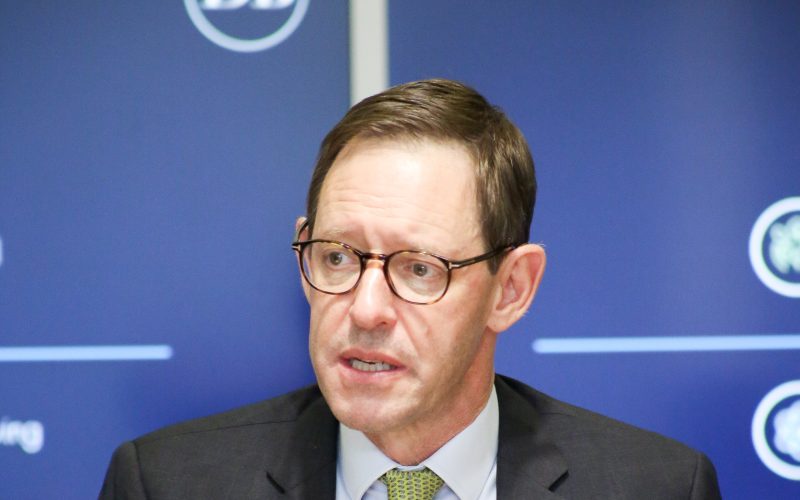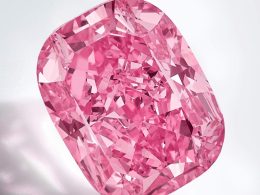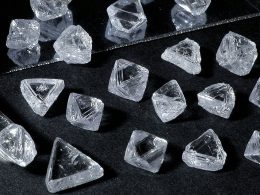The diamond industry changed tremendously in the nearly seven years that Bruce Cleaver was Chief Executive Officer (CEO) of De Beers Group. Cleaver left the role on 20 February 2023 to become the Co-chair of the company, succeeded by Al Cook as CEO, but here he shares his reflections on his time as CEO and on the opportunities that lay ahead for De Beers and the diamond industry.
While Cleaver will no longer oversee the day-to-day operations of De Beers, he will continue to play an important role in guiding the direction of the world’s leading diamond company through his role on the Board and will remain engaged in the sales agreement negotiations with the Government of Botswana.
Bruce Cleaver presided over De Beers during a period defined by unprecedented global events, ongoing industry transformation and rapidly evolving consumer expectations relating to diamonds. He became the CEO of De Beers in July 2016, succeeding Philippe Mellier. Prior to taking over as De Beers Chief Executive, he held several key portfolios in the Group, including serving as De Beers’ Executive Director responsible for strategy and commercial relationships until 2015, also serving as Co-Acting CEO for a year prior to Philippe Mellier’s appointment in 2011. He was Group Director of Strategy and Business Development for Anglo American in 2015.
“I led De Beers for just under seven years. I’ve always felt there is a limit to how long a CEO should do a role because it is important to embrace fresh ideas in a business. In the seven years that I was in the role, the diamond industry changed enormously, and I think we should be prepared for change at a similar pace in the next seven years or so,” Cleaver told the media recently.
Cleaver has been succeeded by Al Cook, a former energy executive, and was actively involved in his recruitment. Cook was Executive Vice President for International Exploration and Production at Equinor, Norway’s state-owned energy company. While Cook is new to the diamond industry, Cleaver is confident that the experience he brings from his previous roles will be instrumental in his role as De Beers Chief Executive.
“De Beers is a unique business. I know no other business where you are involved in exploration; mining from the land and recovering diamonds from the sea; sorting, valuing and selling diamonds; having a retail business; marketing diamonds; having a lab-grown business; and having very important joint venture relationships in Botswana and Namibia,” said Cleaver on De Beers’ decision to appoint Cook his successor.
“Our priority was to find someone with experience in as many of those areas as possible. We came to select Al [Cook] unanimously. He comes from oil and gas, and we think there are similarities between oil and gas and our business. The oil and gas industry does exploration, mining, has very strong customer relations, and very strong relationships with governments-all areas in which Al has extensive experience, including in joint ventures. He is also supported by the wider De Beers Group executive leadership team that has a wealth of diamond industry experience which Al can draw on as he settles into the role.”
When announcing Cleaver’s end of tenure as CEO, the company attributed several milestones to his leadership, including leading the business’s transformation across the value chain.
During his tenure, De Beers launched the world’s largest and most sophisticated diamond recovery and exploration vessels; redesigned supply agreements with Sightholders to enhance the efficiency of rough diamond distribution; integrated the organisation’s downstream businesses; created Tracr™ – the world’s only distributed diamond blockchain that starts at the source and launched the Lightbox Jewelry laboratory-grown diamond business; as well as establishing and embedding the Building Forever sustainability framework across the Group, including setting 12 ambitious sustainability goals for 2030.
Said Duncan Wanblad, the Chief Executive of Anglo American and Chairman of De Beers: “Bruce has led De Beers with distinction, evolving the company’s strategic vision to ensure that consumers’ desire for diamond jewellery is at the very heart of decision making across the diamond pipeline, while leading a safety transformation to ensure employee safety and wellbeing are recognised as the first priority and a shared responsibility. He has successfully steered De Beers through a period of considerable change over the last six years, including leading the way through technology to provide consumers with absolute assurance of the ethical provenance of their diamonds.
Bruce has successfully expanded De Beers’ horizons for the longer term and reinforced the company’s unquestioned leadership position, exemplified by De Beers’ Building Forever sustainability framework to ensure an enduring positive diamond legacy. I look forward to his contribution as Co-Chairman, ensuring the greatest continuity for the business, our partners and stakeholders.”
These achievements were also made as Cleaver and De Beers had to contend with significant global challenges impacting not only De Beers as a company, but also the entire diamond industry. Among the key challenges faced were the Covid-19 pandemic, which had an unprecedented impact on the diamond value chain and saw De Beers have to cancel a Sight for the first time since the Second World War. In response to the pandemic, De Beers reprioritised its focus to protect employees and host communities from the spread of the virus. The company also leveraged its global supply chain to support its partner countries in procuring hard-to-source medical supplies and Covid-19 testing equipment.
NEGOTIATIONS WITH THE GOVERNMENT OF BOTSWANA
Cleaver will continue to play a key role in De Beers Group’s negotiations with the Government of Botswana for a new sales agreement and also for the extension of the mining licence for Debswana. It is the first time that negotiations for a mining licence agreement and sales agreement have been held concurrently.
As negotiations continue, Cleaver is optimistic that the long-standing partnership between De Beers and the Government of Botswana will continue to be successful, underpinned by a mutual desire to deliver long term value for the people of Botswana and by De Beers Group’s strong leadership position within the diamond industry, which enables it to bring unique benefits to the partnership.
“Around two-thirds of global rough diamond supply is produced by two players: De Beers and Alrosa. The remaining players are smaller businesses that do not operate at the same scale. They are good businesses, but smaller. You need scale to be successful in this business because all these things that we do, like spending money on driving consumer demand, investing in Tracr, and dealing with the threat of lab-grown diamonds needs scale, and it needs funding,” Cleaver said.
“I think the two big players have probably got bigger in the last 10 years. We have seen some other players fall away. As De Beers we focus on working as best as we can with our partners in government to demonstrate to them that we have the best offering and to work with them to deliver their aspirations as much as our aspirations.”
FUTURE OF NATURAL DIAMONDS
Cleaver, who left the role of CEO just three weeks ago, indicated that consumer desire for natural diamonds continues to be very strong, supported by the company’s ongoing investments in marketing. In fact, demand has reached record levels in recent years. The United States (US) is the largest market for consumer demand, at around half of global demand, with China and India also being very important markets.
“We sometimes forget that it will not help to mine if people do not buy. We spend $200 million (over P2.6 billion) a year marketing natural diamonds. Without that, there will be less demand, but we need demand to keep selling this amazing product,” Cleaver said.
However, consumer expectations are evolving at a rapid pace and today’s diamond consumers have new demands as the basis for continuing to buy diamonds.
“Diamond provenance has become a big thing, which it wasn’t maybe five or 10 years ago. We will need to continue to tell an integrated story, across all De Beers operations, to consumers about the good that diamonds have done,” he said.
“Five years ago, nobody asked you if your diamond was carbon-neutral, now every retailer in America asks you that question. Soon enough, every consumer in America will ask such a question, and soon other major markets will follow suit.”
“Today’s consumers desire diamonds as much as their parents did before them, but consumers have changed. They are very different to the way their parents used to be, particularly in America. Consumers are rightly very interested in the good the diamond they bought did. They are very interested in things like the carbon footprint of the diamond, and they are very interested in the story one can tell about a diamond.”
Cleaver said with provenance becoming critical in driving consumer demand, De Beers has invested in its Tracr platform, which provides confidence that a diamond was discovered by De Beers in Botswana, Canada, Namibia or South Africa, underpinned by blockchain technology. Tracr is the world’s only distributed diamond blockchain that starts at the source and provides tamper-proof source assurance at scale, enabling De Beers Group’s Sightholders to provide an immutable record of a diamond’s provenance, and empowering jewellery retailers to have confidence in the origin of the diamonds they purchase.
De Beers started deploying the Tracr blockchain platform at scale for its diamond production in 2022. The company is now uploading around 100,000 diamonds on Tracr at each Sight, representing more than half of its rough diamond production by value.
“The diamond industry has become integrated, from exploration to retail. Gone are the days when you say what happened at the mine does not matter as long as you buy my diamond. You do not buy the diamond unless you know what happened when the mining started,” Cleaver stated.
De Beers, as a key player in the industry, has also continually monitored the evolution of lab-grown diamonds and their use in jewellery, which has been increasing both in quantity and quality over recent years. In a strategic move, in 2018, De Beers announced that it was launching its own lab-grown diamond brand, Lightbox Jewelry, to bring something different to the lab-grown diamond sector and help educate consumers about lab-grown diamonds and how they are a different product – both in financial and emotional value – to natural diamonds. The company launched Lightbox on the back of more than 50 years of experience in producing lab-grown diamonds for industrial purposes through its Element Six business.
“When we launched Lightbox, there were many people trying to sell lab grown diamonds as the same thing as natural diamonds. They said it’s the same thing, and it is cheaper. We launched this business called Lightbox deliberately to help educate retail clients on the difference between the two products. We have been pretty successful so far. If you look at the prices of wholesale lab grown, they have come down 90 percent since we launched, which proves that they are not the same thing because they are 90 percent cheaper than natural diamonds,” he added.
“We regard these as two different categories. We regard natural diamonds as our core business for luxury. That’s what we think natural diamonds are. The category of lab-grown diamonds is not going away, it will be here. In our view, it is a legitimate business, but it is fashion, and it is not luxury. It is not expensive. If De Beers continues to do its job right, I think these two markets will separate and happily co-exist.”
SUPPORTING THE GOVERNMENT OF BOTSWANA’S ASPIRATIONS
With sales agreement negotiations ongoing between De Beers and the Government of Botswana, De Beers understands that maximizing economic value to Botswana is a valid expectation and is ready to support Botswana’s economic aspirations.
“The Government of Botswana has an aspiration which we 100% support, that every single diamond mined in Botswana, that is capable of being economically cut and polished in Botswana, must be cut and polished in Botswana. We fully support that,” Cleaver said.
“Our clients are setting up operations in Botswana on the back of us allocating a long-term supply to companies that operate cutting and polishing factories in country.”
Cleaver highlighted: “When we started here, there were a relatively small number of factories in Botswana, and by the end of 2022 there were 31. It is an incredible achievement, these are all international businesses, mostly Indian, but also from other countries.”
In 2006, a new joint venture operation was established, DTCB, which undertakes sorting and valuing of Botswana’s diamonds. Later on, in 2013, De Beers Group moved its sales activities to Botswana, through the establishment of the Global Sightholder Sales business in Gaborone.
“About 50 percent of people working at De Beers Global Sightholder Sales were experts from London. Now that number is eight percent. Ninety-two percent of people working here are Batswana. That’s a great achievement. De Beers supports the participation of Botswana further in the value chain,” stated Cleaver.
“If you look at the number of Batswana working in De Beers in London, it has gone up over the years. There are very capable and talented people, and currently 10% of our Batswana employees are on international assignments in strategic markets. We are very committed to the development and training of our people, and this will continue to be a priority going forward.”








